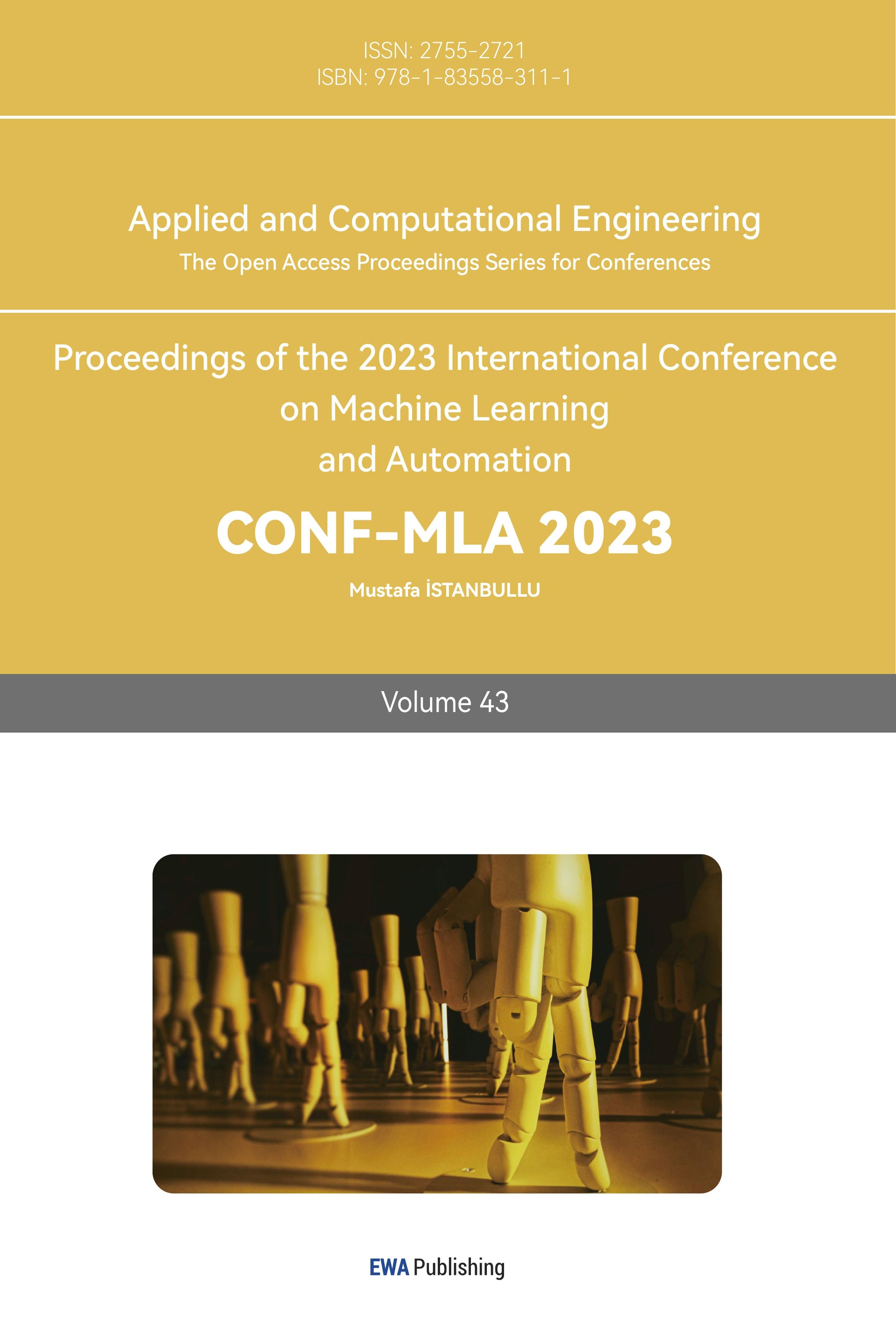References
[1]. Esteva, A., Kuprel, B., Novoa, R. A., Ko, J., Swetter, S. M., Blau, H. M., & Thrun, S.: Dermatologist-level classification of skin cancer with deep neural networks. Nature, 542(7639), 115-118 (2017).
[2]. Cruz-Roa, A., Gilmore, H., Basavanhally, A., Feldman, M., Ganesan, S., Shih, N., and Madabhushi, A.: Accurate and reproducible invasive breast cancer detection in whole-slide images: A deep learning approach for quantifying tumor extent. Scientific Reports, 3, 1564 (2013).
[3]. Huang, P. S., Wei, C. Y., Chen, C. H., Wu, T. T., Chen, Y. Y., & Chen, C. C. An intelligent breast cancer detection system using support vector machines. Journal of Medical Systems, 35(5), 1165-1174 (2011).
[4]. Cheng, J. Z., Ni, D., Chou, Y. H., Qin, J., Tiu, C. M., Chang, Y. C., ... & Wang, X. Computer-aided diagnosis with deep learning architecture: Applications to breast lesions in US images and pulmonary nodules in CT scans. Scientific Reports, p 6, 24454 (2016).
[5]. Kazerooni, F., Lotfollahi, M., et al.: Deep neural network-based classification of breast cancer histopathological images using transfer learning. Computer Methods and Programs in Biomedicine, p 208, 106252 (2021).
[6]. The National Health Service, https://www.nhs.uk/ (2023).
[7]. IBM Watson for Oncology, https://www.ibm.com/watson/health/oncology-and-genomics/oncology/ (2023).
[8]. Breast cancer gene expression - CuMiDa | Kaggle,[EB/OL], https://www.kaggle. com/datasets/brunogrisci/breast-cancer-gene-expression-cumida (2020).
[9]. Feltes, B.C., Chandelier, E. B., Grisci, B. I., Dorn, M.: CuMiDa: An Extensively Curated Microarray Database for Benchmarking and Testing of Machine Learning Approaches in Cancer Research. Journal of Computational Biology, p 26 (4), pp 376-386 (2019).
[10]. Lloyd, S. P.: Least squares quantization in PCM. IEEE Transactions on Information Theory, p 28(2), pp 129-137 (1982).
[11]. MacQueen, J.: Some methods for classification and analysis of multivariate observations. Proceedings of the Fifth Berkeley Symposium on Mathematical Statistics and Probability, p 1(14), pp 281-297 (1967).
[12]. Breiman, L.: Random forests. Machine Learning, p 45(1), pp 5-32 (2001).
[13]. Yu, Q., Chen, P., Lin, Z., et al.: Clustering Analysis for Silent Telecom Customers Based on K-means++, 2020 IEEE 4th Information Technology, Networking, Electronic and Automation Control Conference (ITNEC). IEEE, 2020, 1: 1023-1027 (2023).
[14]. Scikit-learn; Machine Learning in Python [EB/OL], https://scikit-learn.org/ (2023).
Cite this article
Lin,Z. (2024). Breast cancer classification based on hybrid machine learning model. Applied and Computational Engineering,43,94-98.
Data availability
The datasets used and/or analyzed during the current study will be available from the authors upon reasonable request.
Disclaimer/Publisher's Note
The statements, opinions and data contained in all publications are solely those of the individual author(s) and contributor(s) and not of EWA Publishing and/or the editor(s). EWA Publishing and/or the editor(s) disclaim responsibility for any injury to people or property resulting from any ideas, methods, instructions or products referred to in the content.
About volume
Volume title: Proceedings of the 2023 International Conference on Machine Learning and Automation
© 2024 by the author(s). Licensee EWA Publishing, Oxford, UK. This article is an open access article distributed under the terms and
conditions of the Creative Commons Attribution (CC BY) license. Authors who
publish this series agree to the following terms:
1. Authors retain copyright and grant the series right of first publication with the work simultaneously licensed under a Creative Commons
Attribution License that allows others to share the work with an acknowledgment of the work's authorship and initial publication in this
series.
2. Authors are able to enter into separate, additional contractual arrangements for the non-exclusive distribution of the series's published
version of the work (e.g., post it to an institutional repository or publish it in a book), with an acknowledgment of its initial
publication in this series.
3. Authors are permitted and encouraged to post their work online (e.g., in institutional repositories or on their website) prior to and
during the submission process, as it can lead to productive exchanges, as well as earlier and greater citation of published work (See
Open access policy for details).
References
[1]. Esteva, A., Kuprel, B., Novoa, R. A., Ko, J., Swetter, S. M., Blau, H. M., & Thrun, S.: Dermatologist-level classification of skin cancer with deep neural networks. Nature, 542(7639), 115-118 (2017).
[2]. Cruz-Roa, A., Gilmore, H., Basavanhally, A., Feldman, M., Ganesan, S., Shih, N., and Madabhushi, A.: Accurate and reproducible invasive breast cancer detection in whole-slide images: A deep learning approach for quantifying tumor extent. Scientific Reports, 3, 1564 (2013).
[3]. Huang, P. S., Wei, C. Y., Chen, C. H., Wu, T. T., Chen, Y. Y., & Chen, C. C. An intelligent breast cancer detection system using support vector machines. Journal of Medical Systems, 35(5), 1165-1174 (2011).
[4]. Cheng, J. Z., Ni, D., Chou, Y. H., Qin, J., Tiu, C. M., Chang, Y. C., ... & Wang, X. Computer-aided diagnosis with deep learning architecture: Applications to breast lesions in US images and pulmonary nodules in CT scans. Scientific Reports, p 6, 24454 (2016).
[5]. Kazerooni, F., Lotfollahi, M., et al.: Deep neural network-based classification of breast cancer histopathological images using transfer learning. Computer Methods and Programs in Biomedicine, p 208, 106252 (2021).
[6]. The National Health Service, https://www.nhs.uk/ (2023).
[7]. IBM Watson for Oncology, https://www.ibm.com/watson/health/oncology-and-genomics/oncology/ (2023).
[8]. Breast cancer gene expression - CuMiDa | Kaggle,[EB/OL], https://www.kaggle. com/datasets/brunogrisci/breast-cancer-gene-expression-cumida (2020).
[9]. Feltes, B.C., Chandelier, E. B., Grisci, B. I., Dorn, M.: CuMiDa: An Extensively Curated Microarray Database for Benchmarking and Testing of Machine Learning Approaches in Cancer Research. Journal of Computational Biology, p 26 (4), pp 376-386 (2019).
[10]. Lloyd, S. P.: Least squares quantization in PCM. IEEE Transactions on Information Theory, p 28(2), pp 129-137 (1982).
[11]. MacQueen, J.: Some methods for classification and analysis of multivariate observations. Proceedings of the Fifth Berkeley Symposium on Mathematical Statistics and Probability, p 1(14), pp 281-297 (1967).
[12]. Breiman, L.: Random forests. Machine Learning, p 45(1), pp 5-32 (2001).
[13]. Yu, Q., Chen, P., Lin, Z., et al.: Clustering Analysis for Silent Telecom Customers Based on K-means++, 2020 IEEE 4th Information Technology, Networking, Electronic and Automation Control Conference (ITNEC). IEEE, 2020, 1: 1023-1027 (2023).
[14]. Scikit-learn; Machine Learning in Python [EB/OL], https://scikit-learn.org/ (2023).









